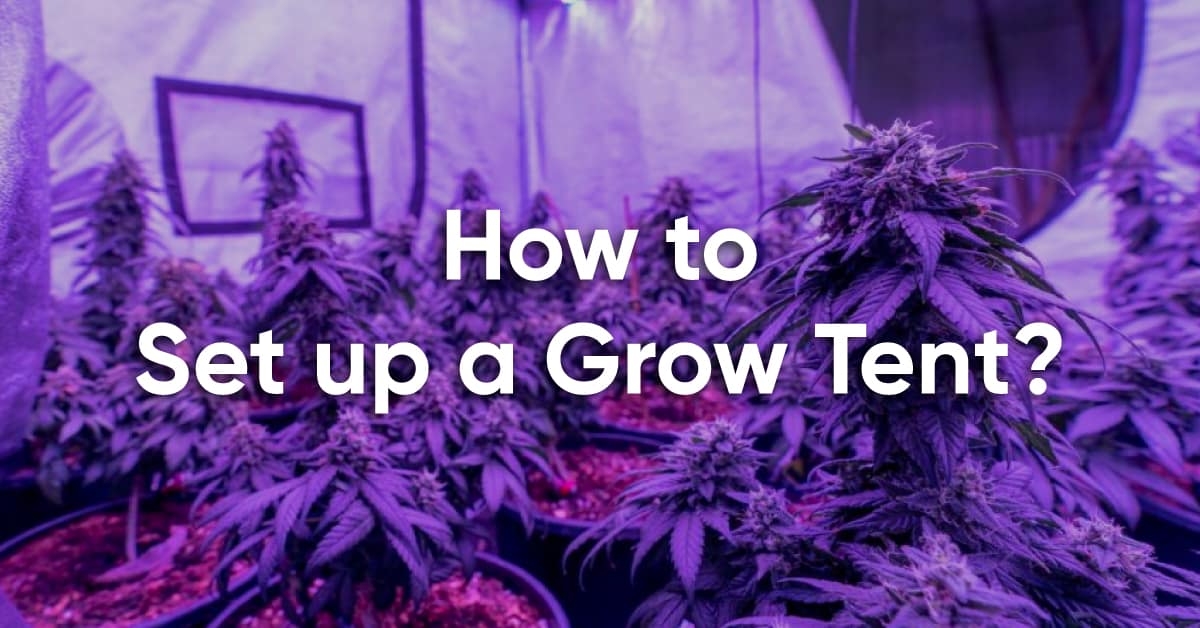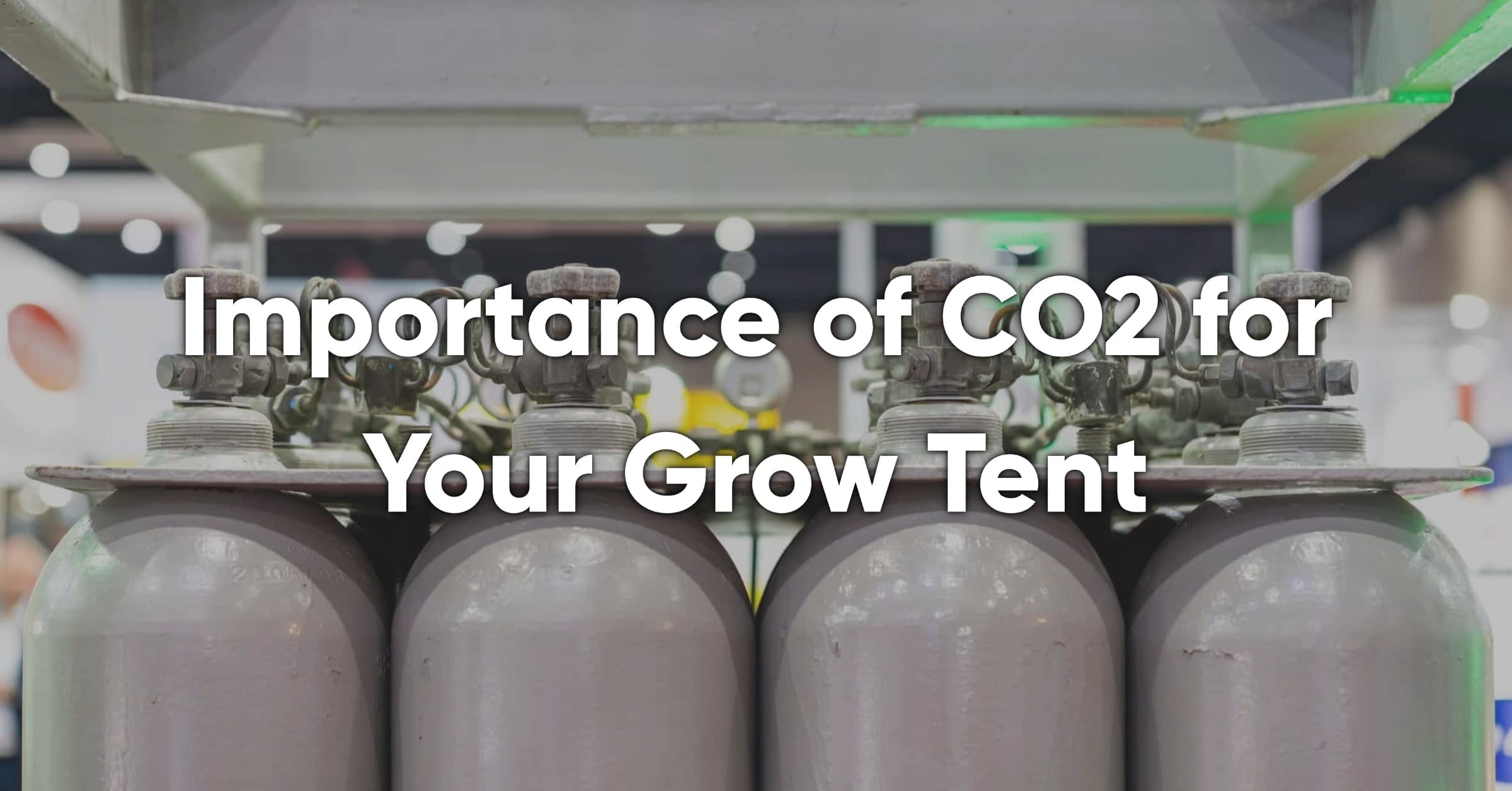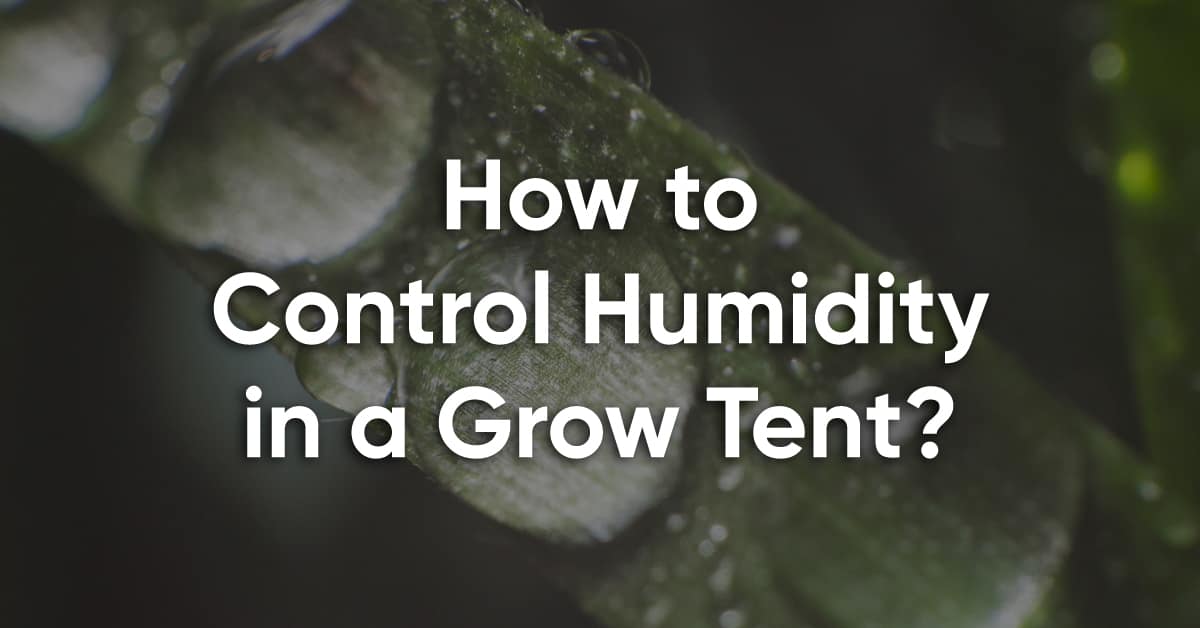Grow Tent Ventilation: Optimizing Airflow for Healthier Plants
Proper ventilation is one of the most critical yet often overlooked aspects of growing cannabis in any grow space. A well-ventilated space ensures optimal air exchange, temperature control, and humidity regulation, all of which contribute to flourishing plants and higher yields!
Ventiation also promotes air movement within the grow tent, allowing air to move between the plants, branches, and canopy. This movement helps water transpiration and prevents the formation of microclimates—small pockets of stagnant air with varying conditions.
Poor ventilation in grow tents can lead to heat and humidity buildup, stagnant air, mold growth, and other stressful conditions that put pressure on the plant, hinder development and slow growth.
What is a Grow Tent Ventilation System?

A grow tent ventilation system is used to control the humidity, temperature, vapor pressure deficit (VPD), as well as to ensure there's fresh air moving into or through the tent. A complete grow tent ventilation system consists of multiple components, including oscillating fans, an exhaust fan, ducting, and a carbon filter.
The oscillating fans are responsible for moving air around and in between the plants, which is necessary for plant health and optimal growth. The exhaust fan works in tandem with the ducting, pulling out hot, humid, or stangnant air out of the grow tent. The exhaust air is then forced through the carbon filter, which neutralizes any odor by trapping smell-producing particulates. This helps you get rid of the cannabis smell and keep your grow discreet!
Importance of Ventilation in a Grow Tent
Adequate ventilation is vital for any grow space, but especially in a grow tent. It's because most tents are not equipped with full HVAC systems & controls. Ideal grow tent ventilation design has multiple benefits:
Humidity Control
Without adequate ventilation, humidity levels inside the grow tent would build to dangerous levels. If too much humidity is held in the grow tent, it's likely to dramatically slow growth, increase chances of mold and bacterial growth.
This can also attract pests and and lead to waterlogged soil, resulting in overwatered plants and slow development.
Temperature Regulation
Ventilation is needed in the grow tent to help maintain proper temperature. Since most grow tents are not equipped with HVAC systems, they rely heavily on the ventilation system to do the job.
When the hot air is vented out, it allows cool, fresh air to enter the tent via either intake fan or passive intake-ventilation. This process is known as air exchange, which directly influences the plants' ability to breathe, photosynthesize, and stay resilient against environmental stressors.

Odor Control
Odor control is often underestimated yet highly important. Besides the legal factors of wanting to keep the cannabis grow discreet, there are other factors needed to be considered when thinking about odor control or mitigation!
Even in areas where cannabis cultivation is legal, you'll want to keep the smell down to protect your grow, as well as your home. Often times thieves are alarmed by the smell of fresh-grown cannabis, and can easily follow the trail of aroma directly to its origin.
Additionally, not everyone enjoys the smell of cannabis. In fact, many find it repulsive and off-putting. If your neighbors, roommates, or anyone who is in close proximity has an issue with the smell, it may cause issues moving forward.
Pest Prevention
Stagnant air creates a breeding ground for cannabis plant pests, such as spider mites, thrips, and aphids, as well as fungal diseases like powdery mildew. If air is not exchanged regularly, humidity levels can spike, creating ideal conditions for pests to thrive. A steady flow of fresh air, combined with internal air movement from grow tent fans, can help reduce the likelihood of these problems, as pests and pathogens struggle to survive in a well-ventilated environment.
Plant Health
Internal airflow, temperature control, humidity control, air exchange, pest prevention, oxygen levels, and transpiration are all vital factors for plant health—and they all depend on proper grow tent ventilation design.
Opt for a Complete Tent Kit with Effortless Ventilation
"Setting up your grow tent ventilation system can be a hassle. If you want to start growing quickly with minimal effort, check out Hey abby GrowMate!"
Hey abby’s GrowMate is a smart grow tent kit that simplifies everything—from the ventilation setup to the light installation. Set it up in just 20 minutes with ease, all by yourself. The air exchange system is controlled by an intuitive, user-friendly AI controller attached directly to the grow tent. If the controller detects any unusual environmental changes, like high temperatures, it automatically adjusts the ventilation to maximum mode.
With GrowMate, you can forget about the hassle of setup, equipment management, programming, and time-consuming tasks throughout the grow cycle.
Things Needed for Grow Tent Ventilation Setup
1. Exhaust Fan
The exhaust fan in tent is the heart of the ventilation system! The most important part about the exhaust fan is making sure you have one that is powerful enough to adequately ventilate your tent!
To determine the correct fan size and power, first measure the tent's volume by multiplying its length, width, and height to get the cubic feet (for example, 4’x4’x7’ = 112 cubic feet).
Then, calculate the required CFM (Cubic Feet per Minute), which measures how much air the fan can move. Ideally, the grow tent exhaust fan should replace the air every 1-3 minutes. Multiply your grow tent's cubic feet by 1.5 or 2 for stronger ventilation. For example, for a 4'x4'x7' tent, 112 cubic feet × 2 = 224 CFM, meaning you'd need a fan rated at least 224 CFM.
The postioning of the exhaust fan is also important for max efficiency. Heat rises, so it's naturally better to place the fan at a higher location. Most growers prefer to set up the exhaust fan above the light and ballast, where it can pull hot air out quickly. Most grow tents come with multiple vent openings. Use the upper exhaust vents for the fan, and leave the lower openings for passive air intake or an additional intake fan (if needed).
2. Ducting
The ducting is used to connect the exhaust fan's exit port to one of the tent's vent holes, allowing the air to be expelled outside of the tent. It's a very basic piece of your grow tent ventilation setup, but also a necessity.
3. Intake Fan (Optional)
Although not mandatory, an intake fan in tent can speed up air exchange and make the exhaust fan run for shorter periods of time. This can in turn reduce energy usage, noise, and odor emissions.
You can also choose to use a passive intake ventilation system by opening some of the lower vents built into the tent. As the exhaust fan removes air, it will create a negative internal pressure which will pull fresh air into the tent from the designated vents.
4. Carbon Filter
The carbon filter should be attached to the INTAKE side of the exhaust fan. You can also put it on the outside of the tent and connect it to the outgoing end of the exhaust ducting. However, I personally have found it less effective, and much more strenuous on the exhaust fan when setting it up this way.
Carbon filters lose their odor-trapping capability over time, and should be replaced every 6-12 months for optimal odor mitigation.
5. Oscillating Fans
Oscillating fans move the air inside the tent around, preventing microclimates (small pockets of differing conditons like cool air or excess humidity) and vapor barriers (humid pockets around the plants that hinder transpiration and even choke the plant out). Without adequate airflow, cannabis plants can suffer from slow growth, nutritional issues, root issues, and even death.
A gentle breeze from grow tent fans mimics natural outdoor conditions, forcing plants to strengthen their stems and branches. This results in sturdier plants that can support more weight, such as heavy buds, which is particularly important during the flowering stage.
Speaking of the flowering stage, airflow also reduces the risk of mold or mildew, especially as buds grow denser. Oscilating fans also help with environmental control. Changing their position and direction can cool or warm plants as needed.
6. Fan Controller (Optional)
A fan controller brings a low level of automation to your grow tent and makes growing a whole lot less work!
Fan controllers typically come with a temperature and humidity sensor that allows growers to turn on/off the exhaust fan automatically based on certain setpoints. For example, if you want to keep the grow tent to stay around 80°F, you can program the fan to turn on when the temperature reaches 82°F, and stop when it drops below 80°F.
If using an intake fan, you may find it beneficial to use a controller that has multiple channels or connection points. This will allow you to connect multiple fans if you ever need it, and also connect the intake fan if you choose to use one.
How to Set up the Ventilation System?

Step 1: Find the right equipment
First you'll need to find and gather the right equipment, including:
- Exhaust fan size: Determine the correct fan size or power by measuring the tent's volume as mentioned above. Then calculate the required CFM. Note: Some tents may require a larger or more powerful fan depending on specific conditions.
- Ducting length/size: Choose ducting that fits your exhaust fan. Then measure the length of ducting needed to connect the fan to the tent's vent and ensure it’s long enough.
- Carbon filter size: Select a carbon filter that also matches the size of your exhaust fan. Most tents typically use a 4-inch fan and filter, but it may vary depending on your tent's conditions. Check if the filter has a CFM rating to match with your exhaust fan. Ensure the filter's length fits comfortably in your tent without causing any obstructions.
- Number and size of oscillating fans: This is determined by your tent size, the number of plants you plan on growing, and how you plan on organizing your plants and utilizing the space. Tpyically, growers use fans between 6-12 inches. Aim for sufficient fan power to move air throughout the entire canopy, ensuring that at some point during oscillation, all leaves should experience airflow. They may not all flutter at once, but every leaf should have slight movement at some point.
- Fan Controller: Finding a controller to easily adjust the fan speed, set timers, and automate operation based on environmental conditions. Some controllers come with automatic settings that adjust the fan speed based on temperature or humidity changes inside the tent. If using an intake fan, opt for a controller with multiple channels or connection points.
- Intake fan (optional): Make sure your intake fan matches the CFM or is slightly lower than the CFM of your exhaust fan. You may want to use it with diffusers as well, so air is blowing directly on the plants and harming them.
Step 2: Set up Exhaust Fan
Find the proper placement for the exhaust fan. Most growers like to place it above the light at the top of the tent. This is because heat naturally rises, and the light and ballast generate significant heat that needs to be expelled.
Then, connect carbon filter to the intake side of the exhaust fan. Make sure it's tightly and securely connected.
Once it's put together, hang the fan and filter in your chosen location. (Using ratchet ties can make this process easy.)
Step 3: Connect Ducting
Connect your ducting to the outgoing end of exhaust fans.
Then connect the other end to the vent hole in the tent.
Step 4: Setup Intake
If you've opted for an intake fan, make sure it's properly hooked up to the ducting, which should connect to a lower vent hole in the tent. Connect the fan to the controller and plug it into a power source.
Alternatively, if you're going with passive intake, open some of the lower vents on the tent to let fresh air enter as the hot air is being sucked out by the exhaust fan. Make sure to open enough vents to maintain adequate airflow, so the tent does not collapse on itself.
**Important: If leaving the vents open, ensure there is no light getting into the tent during dark hours, as light leaks may cause serious hormonal issues with the plant, especially during flowering.
Step 5: Connect Exhaust Fan
Connect the exhaust fan to controller.
Plug both the fan and controller into a power source.
Set your desired setpoints or operation schedule for your fans.
Step 6: Install Oscillating Fans
There are various ways to mount or place these fans, but a recommended method is to mount them in the corners of the tent to minimize stagnant air or dead areas.
Position them either below or above canopy height to allow for gentle airflow.
- Blowing Upward: This helps remove heat from the canopy.
- Blowing Downward: This can warm the plants if they require additional heat.
Step 7: Test Run
Once everything in your grow tent ventilation system is installed, plugged in, and set up, do a test run before any plants are brought in.
Use the controller to manually turn the exhaust fan on and off, then create a setpoint and make sure the fans respond correctly by turning on/off. And do the same with a timer.
Make sure there're enough vents open, or your intake fan is running properly. Ensure there isn't so much negative pressure that could cause the tent to collapse.
Run the oscillating fans at every level to confirm they work properly as well.
I recommend running everything for a full day, using the setpoints, levels and postions you think would typically be needed in any given, growing day. Throughout this "test day", periodically check in on the environmental conditions and make notes of any changes. This will help you create a game plan for setting up your controller, timers and fan settings to keep the environment as optimal as possible with minimal intervention.
FAQs
1. How much airflow does a grow tent need?
That depends on the size of your grow tent, power of your grow lights, and number of plants you are growing.
2. Should grow tent fans stay on all the time?
For oscillating fans, YES! It's good for plants to have constant airflow. It also helps regulate the environment and keeps leaf temperatures stable, especially when the lights are off.
For exhaust fan, NO! If running constantly, it will unnecessarily dry out the environment too much, use A LOT of power, increase odor emissions, and put off constant noise. It's better to set the exhaust fan on a timer using a controller.
3. How to calculate fan size for grow tent?
Exhaust Fan:
To find the right size for your exhaust fan, first measure your tent's volume by multiplying its length, width, and height (e.g., a 4’x4’x7’ tent equals 112 cubic feet). Then, to determine the required airflow (CFM), multiply the tent's volume by 1.5 or 2 for stronger ventilation. For example, for a 4’x4’x7’ tent:
112 cubic feet x 2 = 224 CFM
So, you'll need an exhaust fan rated at least 224 CFM.
Oscillating Fan:
Choose oscillating fans based on your tent size and how many plants you have. Typically, 6-12 inch fans work well. Ensure the fans are powerful enough to circulate air throughout the entire plant canopy.
Get Weekly Expert Tips, and Grow Healthy Plants
Join our newsletter to get exclusive growing tips delivered directly to your inbox.




